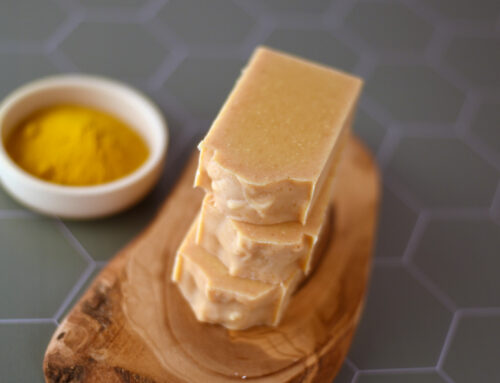There are many types of molds you can use for soaping ranging from more expensive wooden loaf and slab molds to inexpensive “found” molds including Pringles cans, yogurt cups and shoe boxes.
Wooden Loaf Molds – These molds must be lined using freezer paper or other method of lining. In my experience, soap usually gels without added insulation. Soaping in colder climates might require more insulation such as towels or blankets to help force gel completely. You’ll want to purchase a mold made of a hard wood such as poplar that is untreated. Treated wood can react if exposed to unsaponified soap as well as to heat in your oven if you choose to use your mold in the oven for any reason (such as forcing gel).
Wooden Slab Molds – Same as wooden loaf molds.
Plastic or PVC Slab Molds – These are nice if you do not want your soap to gel. Some soapers even put these into the fridge or freezer to stop gel. If you do want to gel your soap, insulate well. You can try wrapping your mold in towels and even putting it on top of a warm heating pad to add heat and help force gel. Soap can be trickier to remove from plastic molds especially if un-gelled or if molds have intricate designs and crevices. Try preparing your mold with mineral oil or add beeswax to your recipe to help release your soap easier.
Individual Cavity Molds – same as Plastic or PVC Slab Molds. Individual cavity molds are especially good for salt bars as they don’t require cutting.
PVC Pipe – Great for making round soap. Molds don’t need to be lined but can be prepared with mineral oil to help soap release easier. After pouring in soap, cover with plastic wrap and a dish towel to insulate the top of mold. Leave soap in mold for 24-48 hours, pop in freezer for an hour and push soap out one end. Slice to desired thickness. I typically get a full gel using PVC pipe. These are the molds that I use in all of my Cold Process Soap classes that I teach. They’re inexpensive and can be used over and over again.
Yogurt cups, Cream Cheese containers and other plastic food containers – Great for small batches or “overflow”. I keep a handful of these containers around for left over soap after I’ve poured my wooden loaf mold. They do not need to be lined.
Shoe boxes and other cardboard boxes – These molds need to be lined. They must be insulated well if you want a full gel. Use towels, blankets and even a warm heating pad to help force gel.
Plastic storage boxes and Tupper Ware containers – If containers are thicker and not easily flexible, you will need to line in order to remove your soap easier. If the container is more flexible, then you may not need to line. They must be insulated well if you want a full gel. Use towels, blankets and even a warm heating pad to help force gel.
Silicone Baking Ware – Great for soaping! These types of molds do not require lining and soap is easily removed because of the flexibility. They must be insulated well if you want a full gel. Use towels, blankets and even a warm heating pad to help force gel. Since silicone can withstand high heat, you can even put your mold in a warm oven to help force gel.
Pringles Cans – Can be used lined or not. If not lined, you can simply peel the container away from the soap and throw away. If you line with freezer paper, you can sometimes get more than one use out of the container. They must be insulated well if you want a full gel or can be put into the fridge or freezer to prevent gel.
Orange Juice Containers – Square cardboard orange juice containers make great molds and produce large square bars of soap. You do not need to line them since they have the waxy coating to begin with. Once your soap hardens you can peel away the container. They must be insulated well if you want a full gel or can be put into the fridge or freezer to prevent gel.
Other molds you can use include wooden drawers, cigar boxes, shipping tubes…the list goes on and on.







Can you use these molds for candle (pvc) making?
Dud I miss the answer to gel reference question?
how long of pvc pipe would I need for 10lbs of soap? or is it better to do in small batches?
I am a rookie in soap making, your tutorials will be of great help.
Thank you
I too would appreciate a full description and explanation of what “gel” is in the soapmaking process. What is it and what is significant about it? How does it fit for into either the cold or hot process?
What does gelling mean? You mention several times to use this or that method, depending on how much gelling of the soap is desired. Thx!